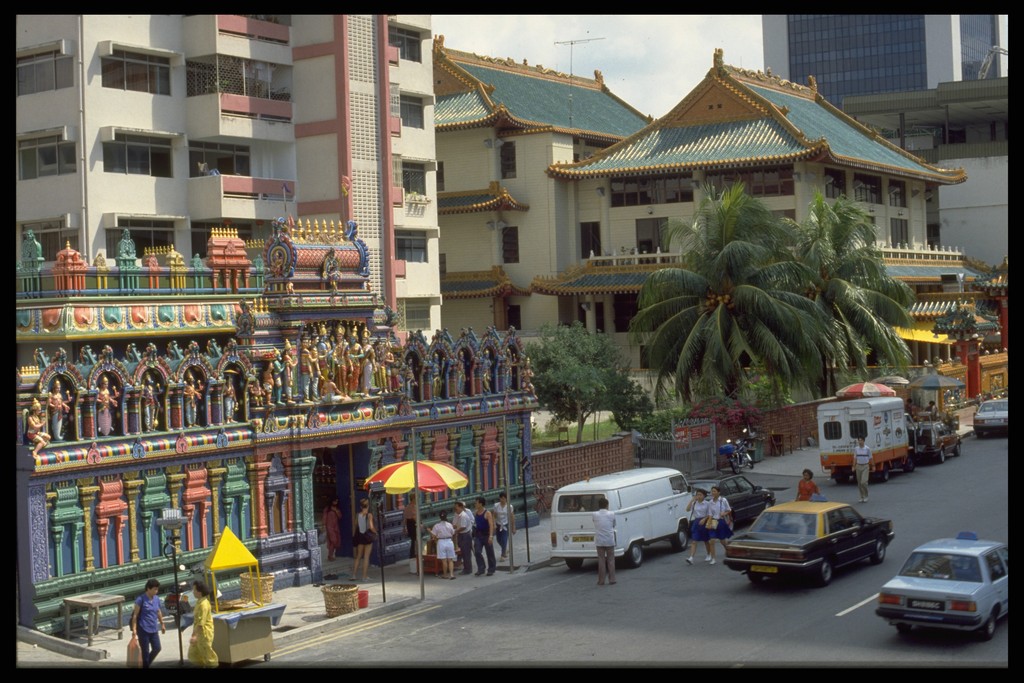农历新年
农历新年是新加坡华人最重要的传统节日。农历年初一和初二是法定公共假期,也是社团组织、亲朋戚友共聚一堂,进行团拜和互道祝福的日子。有些华人家庭也会借此机会招待上门拜年的异族同胞,凸显新加坡多元种族和谐相处的特性。放眼世界,各地华人都有庆祝农历新年的习俗,舞狮表演成为受欢迎的庆祝方式之一。新加坡的舞狮采青贺年亦不例外。
传统家庭腊月(农历十二月)廿四送灶神,又称“送灶君”或“谢灶”,让灶神品尝美味供品,抵达天庭时多说好话,以便来年大家有口安乐茶饭。谢灶后家庭主妇开始准备应节糕点。以广东人为例,传统食品包括煎堆、油角和虾饼,寓意“煎堆碌碌,金银满屋;油角弯弯,家财百万;大虾大虾,食咗笑哈哈”。
除夕夜,新加坡各籍贯人士都有吃团圆饭和守岁的习俗。客家人的菜粄、海南人的薏粑(也称忆粑)、潮州人的白肚鱼(发财鱼)都各具特色。现在“围炉”火锅逐渐盛行,有些家庭则预定年菜,或上餐馆团圆。吃完年夜饭,逛街市补购年货,顺便到庙堂祈福。



初一到十五
新年到了,大家穿上喜庆颜色的衣服、带着年柑,到亲友家拜年,交换祝福。已婚人士给小辈分发红包,讨个吉利。随着手机和无线网络在21世纪普及,人们也流行发短信拜年。
过年期间必须避免一些禁忌,例如大年初一不能用扫帚扫地,否则一整年都不吉利;打破碗碟以“落地开花,富贵荣华”来补运。不中听的食物名称都被改掉了,例如粤语的“蚀”、“干”和“输”,分别以“俐”、“润”和“胜”取代,“猪舌”说成“猪俐”、“猪肝”称为“猪润”,“丝瓜”变成“胜瓜”。“血”亦不吉利,所以“猪血”改称“猪红”。
初二“开年”,把两粒柑和一封红包放在地上,扫到门口后扫回头捡起来,寓意把霉运扫出家门,金银财富留在家里。以前外嫁的女儿一般初一留在夫家招呼客人,初二回娘家,父母准备美味佳肴迎接女儿。
过去有些家庭以姜葱焖鲤鱼开年,“鲤鱼岌岌(点点)头,金银到你手”,取义大吉大利(鲤),年年有余(鱼)。有些人用活鲤鱼祭祖后放生,若鲤鱼转个圈子才离开,则表示生意(鱼)有回头,来年顺顺利利。
大年初三“赤口日”容易招惹口舌是非,因此避免拜年。年初四华人店铺多数开门营业,阔气的老板分发开工红包,请员工吃开工宴。相传这天众神辞别玉皇大帝,返回人间。
正月初七“人日”,鱼生已成为新加坡华人的大众美食。20世纪30年代,大东酒楼推出“好运鱼生”1,1960年代粤菜四大天王(谭锐佳[1928-1996]、冼良、许国威、刘育培[1932-2006])使用香脆七彩的佐料,为鱼生增添风味。潮州人吃七样羹,一般用大菜、芥兰、蒜菜、白菜、厚合、春菜及芹菜煮成,寓意田园不生草。
正月初九“天公生”,是福建人的盛大节日,最重要的祭品是连根带叶的甘蔗。相传明朝时倭寇侵扰福建,村民到蔗林里避过劫难。这一天是大年初九,拜天公就这样流传开来。
正月十五元宵节为新年画上句点。
集体庆祝活动
“春到河畔”和“妆艺大游行”可说是最具新加坡本土特色的集体庆祝活动。

1972年政府推出燃放鞭炮禁令,隔年改以妆艺大游行来制造新年气氛。这个民间参与的年度街头游行庆典,通常在农历新年的第二个周末举行,如今也吸引国际表演团队参与其盛。1987年新加坡宗乡会馆联合总会主办第一届春到河畔,目的是为了保留华族传统,并将此传统传承给下一代。
吃喝玩乐之余,我们可以为新年赋予深一层文化意义,例如进行反思规划,创造美好未来。
| 1 | 《新国民日报》,1933年1月24日。 |
华人礼俗委员会编,《华人礼俗节日手册》。新加坡:新加坡宗乡会馆联合总会,1989。 | |
刘六艺,〈河婆客家人的欢喜年〉。《联合早报》,2017年2月9日。 | |
向海洋,〈海南人做年美食,幸福圆满的滋味〉。《联合早报》,2017年2月16日。 | |
李国樑,〈广东人过年,讲究与避忌〉。《联合早报》,2017年2月4日。 | |
许愫芬,〈一尝潮州人年味〉。《联合早报》,2017年2月11日。 | |
辛羽,〈福建年俗,今昔随想〉。《联合早报》,2017年2月2日。 |










